|
Back to Introduction
We begin our tour at the eastern entrance, at the intersection of Abigail and Lincoln Streets. As we enter, Section E is to our right (west). To the right is a large, empty field that floods whenever the Iroquois River gets unusually high. After only a few yards there is a fork in the road. The left fork forms the eastern edge of the Cemetery and runs to the river, where it turns to the right and runs along the river, forming the southern edge. The right fork turns to the west and splits Section E from Sections A and D.
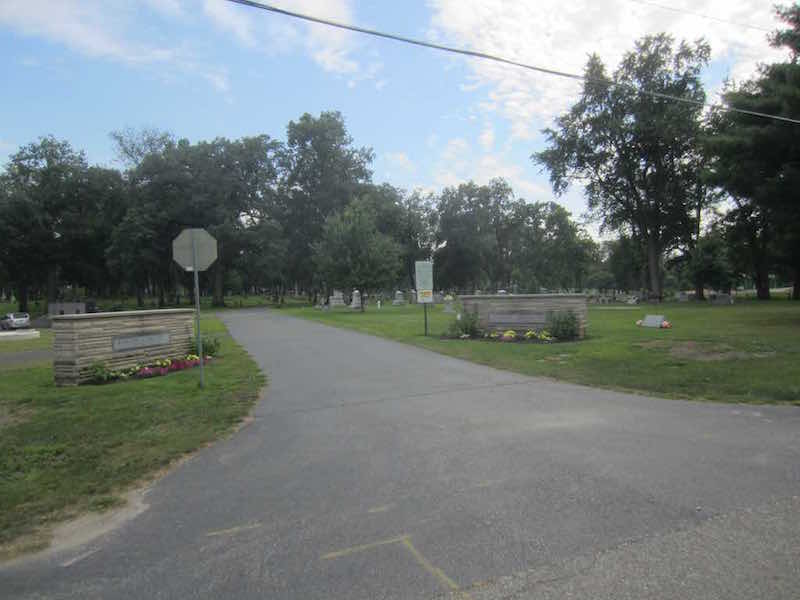 We will follow the left fork and go down a small incline where we will see a strange structure that is partially buried in the hillside. This is the vault and it was constructed to hold bodies if burial had to be delayed.
We will follow the left fork and go down a small incline where we will see a strange structure that is partially buried in the hillside. This is the vault and it was constructed to hold bodies if burial had to be delayed.
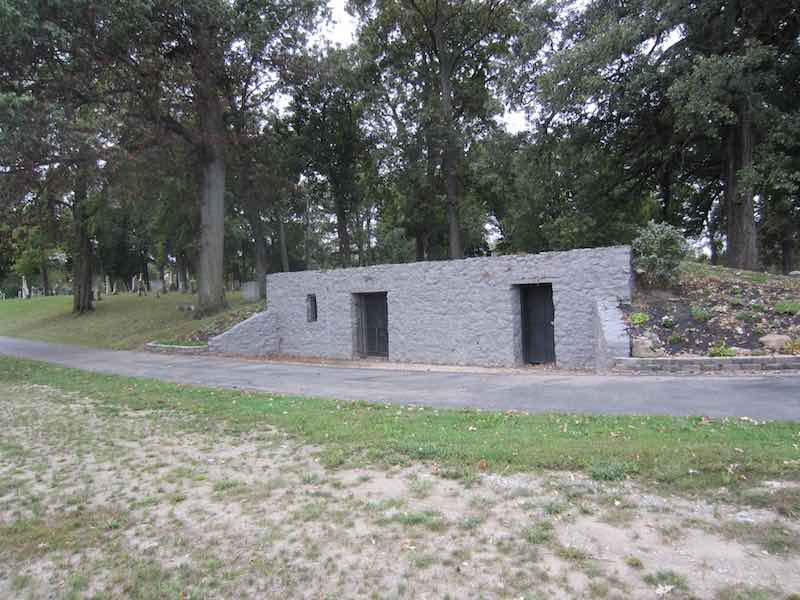 If we scamper up the hill after passing the vault, we will be in a little section known as the Vault addition. Several Babcocks are buried here. William C Babcock was an important part of the Rensselaer business community in the late 19th and early 20th centuries. He was in the grain business and built grain elevators in Rensselaer, Pleasant Ridge, and Parr, among other places. For more information, see this account.
If we scamper up the hill after passing the vault, we will be in a little section known as the Vault addition. Several Babcocks are buried here. William C Babcock was an important part of the Rensselaer business community in the late 19th and early 20th centuries. He was in the grain business and built grain elevators in Rensselaer, Pleasant Ridge, and Parr, among other places. For more information, see this account.
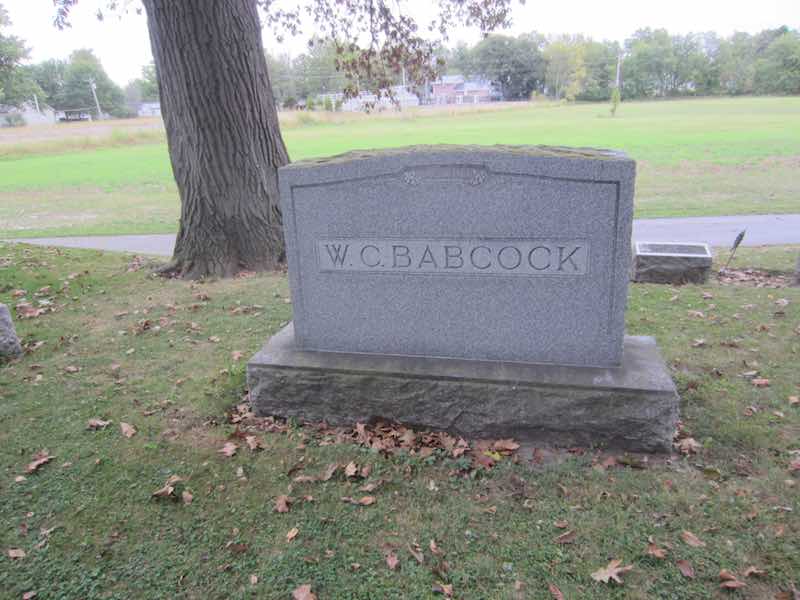 From the Babcock graves we turn to the southwest, looking for three obelisks that mark a row that the Cemetery workers call "Civil War Row". The row contains ten graves of soldiers who died in uniform or shortly after being discharged from the army. Starting on the north end, Chester Sherwood of Company A of the 48th regiment died on Oct. 12, 1863. Next to him is James Watt of the same regiment and company who died in service, but the regimental roster does not give a date. James Kessler of Company K of the 87th regiment died at Indianapolis on July 17, 1863. Sergeant Robert Williams of Company A of the 87th regiment died at Nashville, TN on April 13, 1863. George Weathers of Company E, 9th Regiment was killed at the Battle of Stones Rivers on December 31, 1862. Isaiah Dwiggins Of Company D of the 87th Regiment was discharged on January 14, 1863 and died on March 10, 1863. Soldiers were discharged only when they were of no use for service, which usually meant they were seriously wounded, injured, or ill, so it is likely that his death was war related. His name on the Cemetery records is Isaac, NPS Civil War records have him as Josiah or Isaiah, the cemetery marker says Isaiah, and the Company roster says Israel.
From the Babcock graves we turn to the southwest, looking for three obelisks that mark a row that the Cemetery workers call "Civil War Row". The row contains ten graves of soldiers who died in uniform or shortly after being discharged from the army. Starting on the north end, Chester Sherwood of Company A of the 48th regiment died on Oct. 12, 1863. Next to him is James Watt of the same regiment and company who died in service, but the regimental roster does not give a date. James Kessler of Company K of the 87th regiment died at Indianapolis on July 17, 1863. Sergeant Robert Williams of Company A of the 87th regiment died at Nashville, TN on April 13, 1863. George Weathers of Company E, 9th Regiment was killed at the Battle of Stones Rivers on December 31, 1862. Isaiah Dwiggins Of Company D of the 87th Regiment was discharged on January 14, 1863 and died on March 10, 1863. Soldiers were discharged only when they were of no use for service, which usually meant they were seriously wounded, injured, or ill, so it is likely that his death was war related. His name on the Cemetery records is Isaac, NPS Civil War records have him as Josiah or Isaiah, the cemetery marker says Isaiah, and the Company roster says Israel.
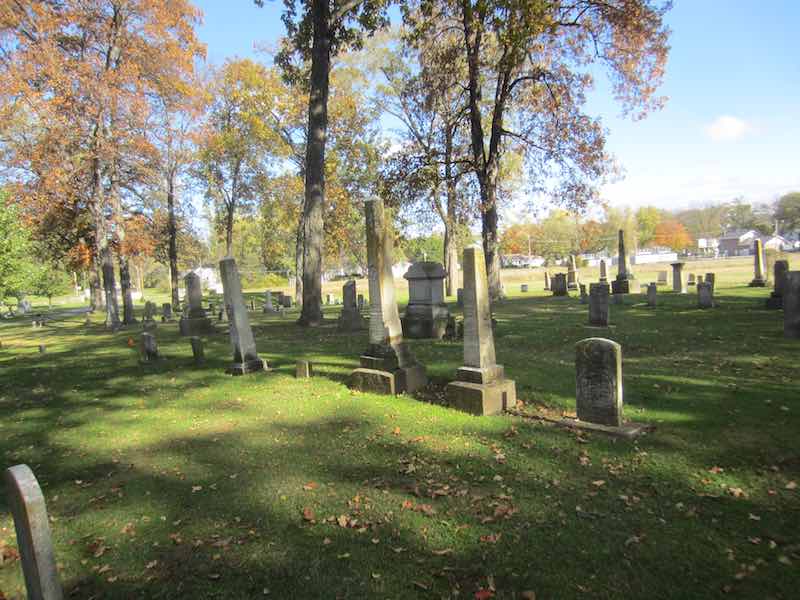 Next is Conard Gilmore, who was discharged January 16, 1863 and who died on January 24, 1863. He was in Company B of the 87th Regiment. Daniel Howard of Company G of the 9th Indiana Infantry died in St. Louis on May 8, 1862 and in the same company and regiment was Henry Young who died at Fetterman, Virginia on February 11, 1862. Finally Charles Rhoades, a member of the 9th Regimental Band, was one of the first three Jasper County soldiers killed in action. He died in the Battle of Cheat Mountain on December 13, 1861.
The hundreds of men from Jasper County who served in the Civil War are listed on the pedestal of the General Milroy statue. Many died in the War and only a few of their bodies were returned for burial in Jasper County. Lists of the soldiers in the Indiana regiments can be found here. The National Park Service allows searching an index of soldiers and sailors. You might think that you could learn more from microfilm copies of Jasper County newspapers, but there are no surviving copies from the Civil War period. Those being stored may have been destroyed in a fire designed to cover a crime.
We continue, walking through Section A, the oldest part of the graveyard. Most of the markers in this section are limestone or sandstone and the years have blurred their inscriptions. The spacing of the graves is irregular and it can be difficult to locate graves of people buried in this section.
Next is Conard Gilmore, who was discharged January 16, 1863 and who died on January 24, 1863. He was in Company B of the 87th Regiment. Daniel Howard of Company G of the 9th Indiana Infantry died in St. Louis on May 8, 1862 and in the same company and regiment was Henry Young who died at Fetterman, Virginia on February 11, 1862. Finally Charles Rhoades, a member of the 9th Regimental Band, was one of the first three Jasper County soldiers killed in action. He died in the Battle of Cheat Mountain on December 13, 1861.
The hundreds of men from Jasper County who served in the Civil War are listed on the pedestal of the General Milroy statue. Many died in the War and only a few of their bodies were returned for burial in Jasper County. Lists of the soldiers in the Indiana regiments can be found here. The National Park Service allows searching an index of soldiers and sailors. You might think that you could learn more from microfilm copies of Jasper County newspapers, but there are no surviving copies from the Civil War period. Those being stored may have been destroyed in a fire designed to cover a crime.
We continue, walking through Section A, the oldest part of the graveyard. Most of the markers in this section are limestone or sandstone and the years have blurred their inscriptions. The spacing of the graves is irregular and it can be difficult to locate graves of people buried in this section.
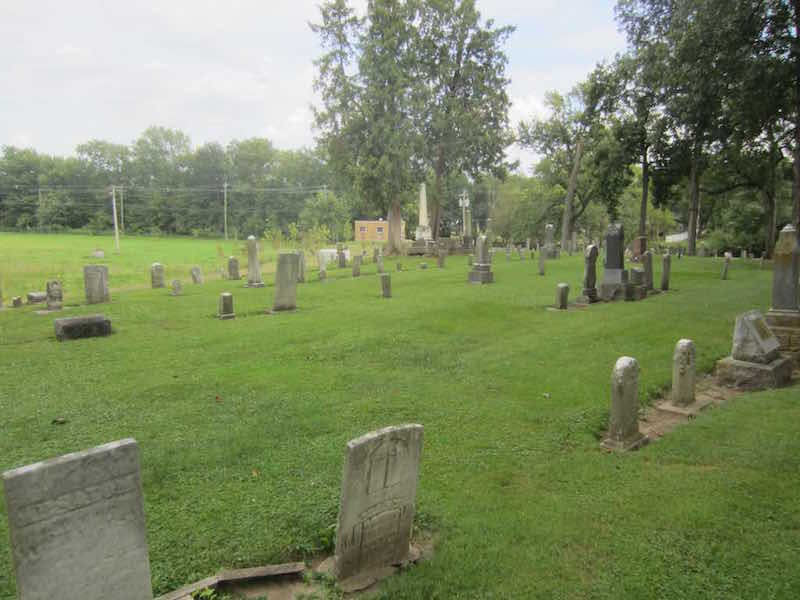 One of the most prominent monuments in this area is that of George Spitler. The Spitlers were an early family in Jasper County and as the monument suggests, quite prominent. George Spitler died in 1862, struck by lightning. For more about his life, see here. In 1867 Bishop Luers of Fort Wayne purchased the George Spitler farm with the intention of establishing an orphanage. Twenty two years later that property became the home of Saint Joseph's College.
One of the most prominent monuments in this area is that of George Spitler. The Spitlers were an early family in Jasper County and as the monument suggests, quite prominent. George Spitler died in 1862, struck by lightning. For more about his life, see here. In 1867 Bishop Luers of Fort Wayne purchased the George Spitler farm with the intention of establishing an orphanage. Twenty two years later that property became the home of Saint Joseph's College.
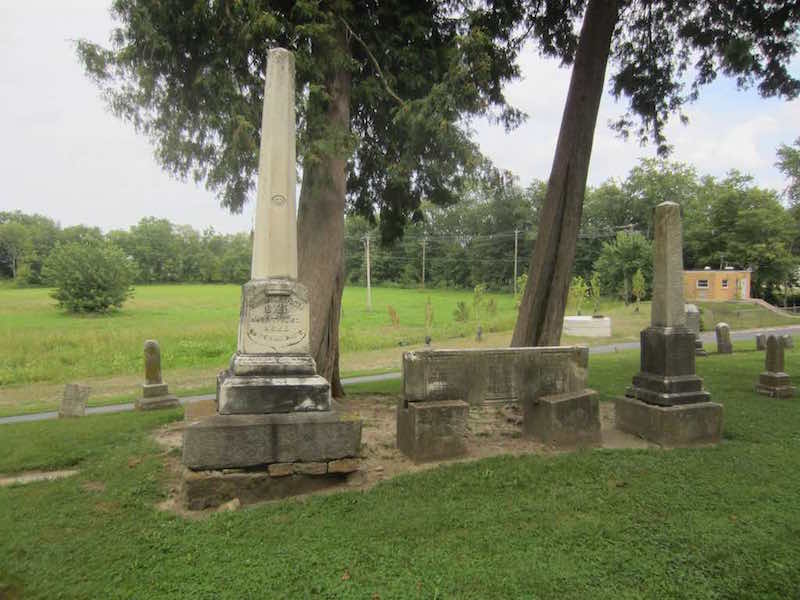
|
Pages:
*******
Next to the Babcock marker is the Paulus marker. Margaret Jane Babcock Paulus, the daughter of W. C. Babcock, spent much time with genealogy and recording information about Jasper County cemeteries.
In the row east of Civil War Row and visible in the picure is the large grave marker of William Rhoades, a Civil War veteran who survived the war. In 1861 he had the unfortunate task of bringing the body of his brother Charles Rhoades home for burial. After William returned from the War, he had a successful business career selling harnesses and other equipment for horses with his father Charles, who is buried several graves to the south of his son Charles. The Rhoades were an early pioneer family that intermarried with other early pioneer families.
Next to William Rhoades' gravestone is the smaller but more ornate marker of John W Warren. It has an elaborate design on the front.
A bit to the west of the Warren marker is the small and hard-to-read marker for Claude Baylor, who while watching rain from his doorway was killed by lightning. He was only ten years old.
A bit to the south of the Spitler obelisk is the first burial in Weston Cemetery, Anna Irwin, wife of Thomas Irwin. She was buried in 1842, only a few years after people settled in Rensselaer. The Cemetery itself was not formally established until 1873.
The small yellow building in the background of several pictures is part of the City's sewage system. It contains three pumps that pump sewage to the sewage treatment plant south of town. When the river floods, the field in the background becomes a pond that breeds frogs, toads, and salamanders.
|





